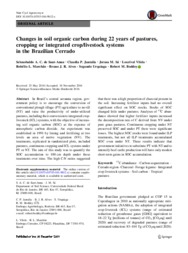Changes in soil organic carbon during 22 years of pastures, cropping or integrated crop/livestock systems in the Brazilian Cerrado.
Changes in soil organic carbon during 22 years of pastures, cropping or integrated crop/livestock systems in the Brazilian Cerrado.
Autoria: SANTA-ANNA, S. A. C. de; JANTALIA, C. P.; SA, J. M.; VILELA, L.; MARCHAO, R. L.; ALVES, B. J. R.; URQUIAGA, S.; BODDEY, R. M.
Resumo: Abstract: In Brazil?s central savanna region, government policy is to encourage the conversion of conventional plough tillage (PT) agriculture to no-till (NT) and raise the productivity of under-utilized pastures, including their conversion to integrated crop-livestock (ICL) systems, with the objective of increasing soil organic carbon (SOC) at the expense of atmospheric carbon dioxide. An experiment was established in 1991 by liming and fertilizing at two levels an area of native vegetation (NV). The treatments, replicated in randomized plots, included pastures, continuous cropping and ICL systems under PT or NT. The aim of this study was to quantify the SOC accumulation to 100 cm depth under these treatments over time. The high C:N ratios suggested that there was a high proportion of charcoal present in the soil. Increasing fertilizer inputs had no overall significant effect on SOC stocks. Stocks of SOC changed little under pastures. Analyses of ¹³C abundance showed that higher fertilizer inputs increased the decomposition rate of C derived from NV under pure grass pastures. Continuous cropping under NT preserved SOC and under PT there were significant losses. The highest SOC stocks were found under ILP treatments, but not all ILP treatments accumulated SOC even under NT. These results indicate that government initiatives to substitute PT with NT and to intensify beef cattle production will have only modest short-term gains in SOC accumulation.
Ano de publicação: 2016
Tipo de publicação: Artigo de periódico
Unidade: Embrapa Cerrados
Observações
1 - Por padrão são exibidas publicações dos últimos 20 anos. Para encontrar publicações mais antigas, configure o filtro ano de publicação, colocando o ano a partir do qual você deseja encontrar publicações. O filtro está na coluna da esquerda na busca acima.
2 - Para ler algumas publicações da Embrapa (apenas as que estão em formato ePub), é necessário ter, no celular ou computador, um desses softwares gratuitos. Sistemas Android: Google Play Livros; IOS: iBooks; Windows e Linux: software Calibre.
Acesse outras publicações
Acesse a Base de Dados da Pesquisa Agropecuária (BDPA) para consultar o acervo completo das bibliotecas da Embrapa.

